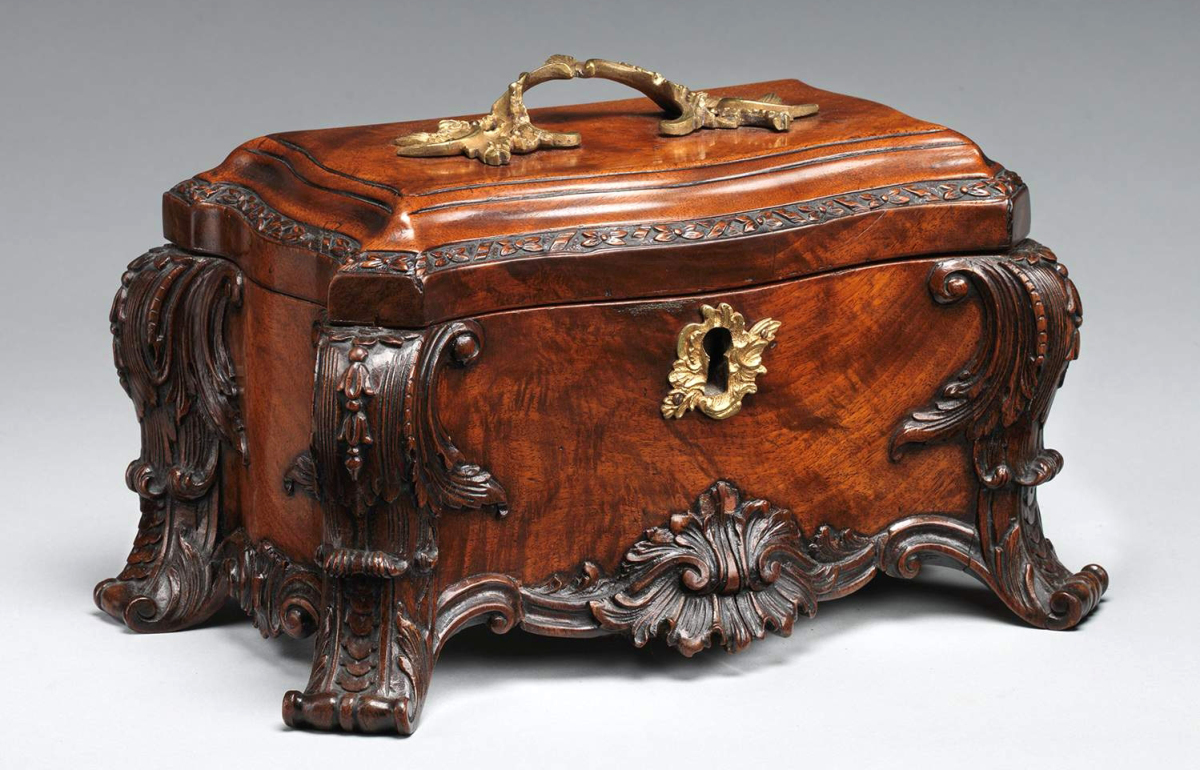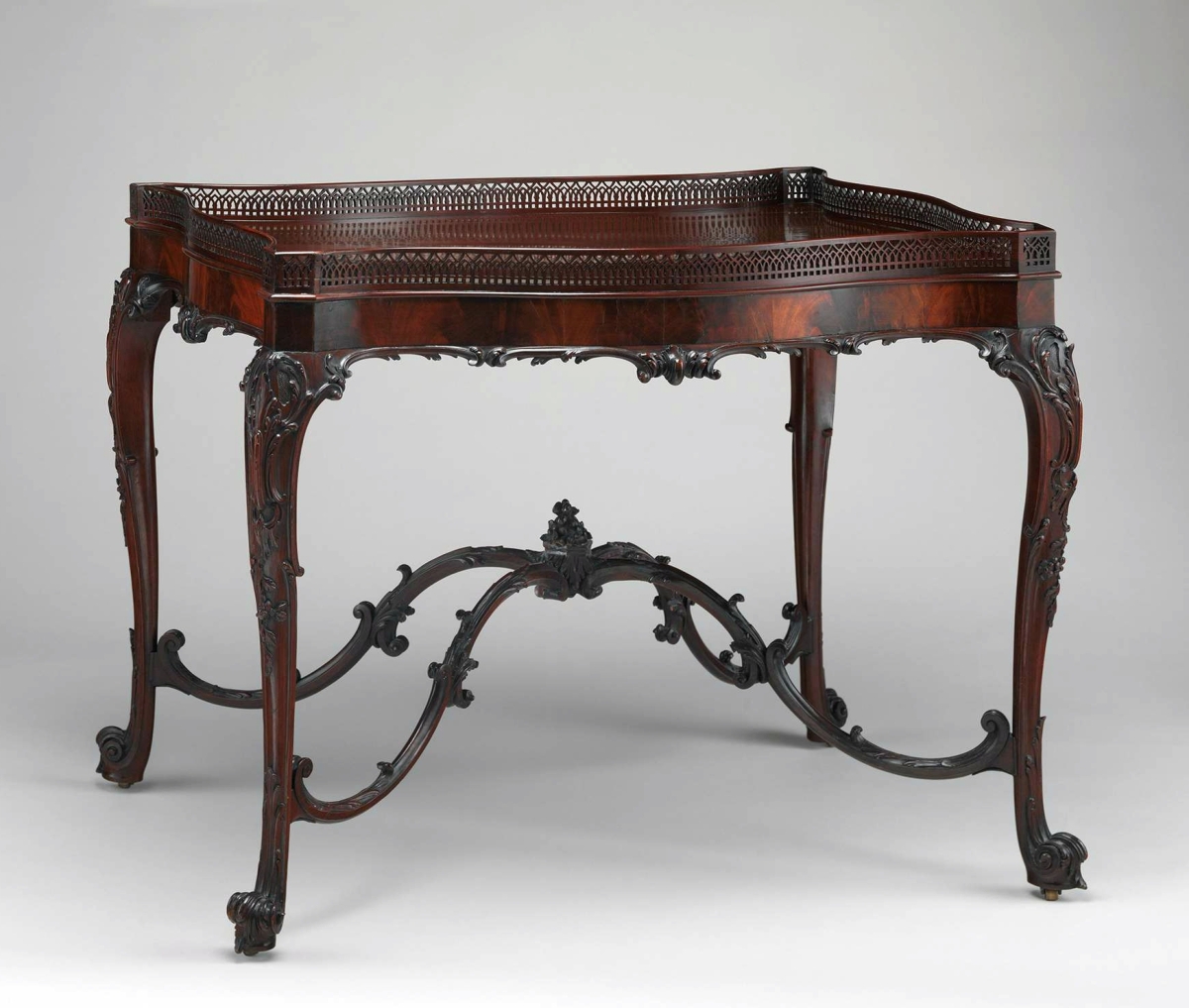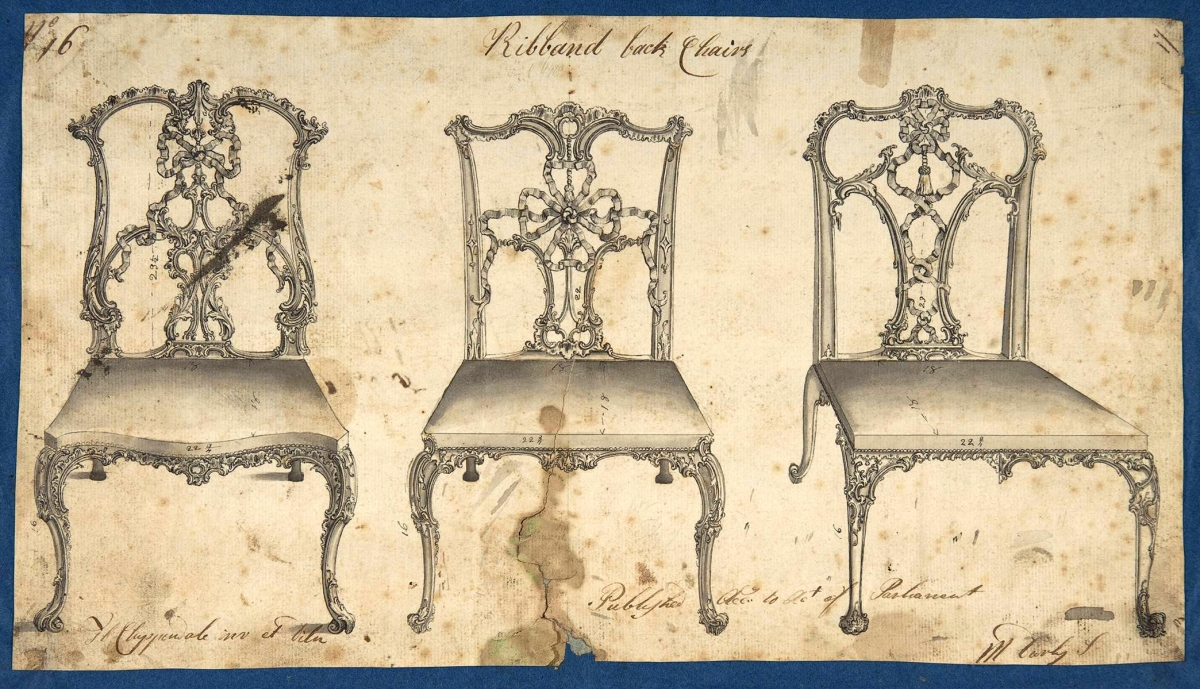
The Eighteenth Century fascination with tea equipage is evidenced in the Director. This elaborate example shares similarities with some of Chippendale’s designs for tea chests. Tea chest, Britain, circa 1760. Mahogany, gilt brass; 6 by 11½ by 6½ inches. Metropolitan Museum of Art, gift of Irwin Untermyer. From “Chippendale’s Director: The Designs and Legacy of a Furniture Maker,” Metropolitan Museum of Art.
By Kate Eagen Johnson
NEW YORK CITY – “The name ‘Chippendale’ was like ‘Kleenex.’ It became shorthand for ‘English Rococo’ and English and American furniture in this style.” The wry Morrison H. Heckscher, curator emeritus of the Metropolitan Museum of Art’s American Wing, coined this charming simile to express the dominance of the legendary moniker. He and other devotees of Thomas Chippendale (1718-1779) are exploiting the 300th anniversary of the cabinetmaker and designer’s birth to refocus attention on this significant talent. During the commemorative year of 2018, exhibitions and events on either side of the Atlantic honor the most famous furniture maker of the Eighteenth Century and perhaps of all time.
A host of museums and organizations have marshaled forces to bring forth “Chippendale 300, 1718-2018, A Celebration of Britain’s Greatest Furniture Maker.” The programming initiative taking place in England, Scotland and the United States is represented by the website www.chippendale300.co.uk. The online clearinghouse lists exhibitions, tours, lectures, demonstrations, workshops, appraisal days, thematic trails, art competitions, concerts and even a tercentenary garden bed planted in Chippendale’s hometown of Otley. Leave it to the English to “say it with flowers.”
Born in Yorkshire, Thomas Chippendale set up a cabinetmaking shop in London by 1748. His establishment grew into something quite large with workshops, a retail shop and a timber yard. Services included interior decoration and even extended to home security. According to Leela Meinertas, curator in the department of textiles and fashion at the Victoria and Albert Museum, one could hire a night watchman to guard the gate through Chippendale’s firm. His entrepreneurial versatility notwithstanding, Thomas Chippendale is best remembered for his pattern book, The Gentleman and Cabinet-Maker’s Director, first published in 1754. Through it, Chippendale portrayed the au courant “tastes” of the Gothic, the Chinese and the Modern – all aspects of a style called the Rococo since the 1840s.
The Chippendale story has its share of unexpected twists. As Heckscher pointed out in conversation, while pieces of furniture can be tied to Chippendale’s workshop, none can be tied with certainty to Thomas Chippendale himself. Because the workshop did not mark its products, researchers have had to rely on primary sources such as correspondence and financial records or on physical comparison to examples with strong provenance when making attributions. While Thomas Chippendale is renowned for his Rococo designs, much of the surviving furniture associated with his business is actually Classical in style, with Chippendale and his team adopting the new Neoclassical mode during the 1760s. The famous cabinetmaker’s son, also named Thomas Chippendale (1749-1822), took over upon his father’s retirement in 1776. The death of business partner Thomas Haig and attendant financial difficulties prompted the closing of the enterprise at St Martin’s Lane in 1804.
Newcomers to Eighteenth Century furniture study are often surprised by the dearth of exact copies of Director images executed in wood. Assistant curator of the Metropolitan Museum’s American wing Alyce Englund explained that Chippendale expected, and in fact encouraged, cabinetmakers to play off these designs rather than replicating them formulaically. She spoke of the pattern book’s “democratic spirit,” an intriguing turn-of-phrase not typically associated with Chippendale design. The Met is paying homage to Chippendale through a multi-pronged effort. Englund and Femke Speelberg, associate curator of drawings and prints, have co-curated “Chippendale’s Director: The Designs and Legacy of a Furniture Maker,” which runs through January 27, 2019 and has been installed in Van Rensselaer Hall and an adjoining gallery. Noting the period room’s carved woodwork and English wallpaper dating from the 1760s, Heckscher observed, “There couldn’t be a more perfect architectural setting for this exhibition.”

For this object, an unidentified furniture maker combined elements from two of Chippendale’s “China Table” designs. China table, England, circa 1755–60. Mahogany; 28¼ by 37¾ by 26½ inches. Metropolitan Museum of Art, gift of Irwin Untermyer, 1964. From “Chippendale’s Director: The Designs and Legacy of a Furniture Maker,” Metropolitan Museum of Art.
While Speelberg and Englund explore Chippendale’s considerable and long-lived influence as a designer, the theme of Chippendale as draughtsman predominates. The co-curators showcase one of the institution’s many treasures, a cache of drawings created by Thomas Chippendale for the Director. During the run of the show, a total of 36 of the museum’s 200 Chippendale drawings will be on view.
Coinciding with the exhibition is the publication of Heckscher’s “Chippendale’s Director: A Manifesto of Furniture Design” in the Spring 2018 issue of The Metropolitan Museum of Art Bulletin. As part of his thought-provoking essay, Heckscher recounts how in 1920, Met curator William M. Ivins Jr recognized that two albums coming up for auction contained many of the finished drawings for the Director. The savvy Ivins scored these sleepers at New York’s Anderson Galleries to the continuing glory of the Metropolitan Museum.
Over the years, some have wondered if a cabinetmaker could have produced such fine drawings, but in Chippendale’s defense, Speelberg emphasized the ubiquity of drawing instruction in England during his time. She believes that 95 percent of the drawings are by the same hand and that the hand is Thomas Chippendale’s. A few are by Thomas Chippendale Jr.
Co-curator Englund underscored that, famous though they are, the drawings have rarely been on public view. “Here, they are shown aside, and in conversation with, the furniture they inspired, making it possible for visitors to see how Chippendale’s ideas were absorbed.” She further stressed the resilience of the style through the Nineteenth and Twentieth Centuries, an era when “Chippendale furniture was reproduced, revitalized and satirized.”
In keeping with the friskiness inherent in the Rococo, more recent riffs include the Post-Modern “Chippendale” chair designed by Robert Venturi and Denise Scott Brown for Knoll in 1984 as well as the 1941 book The Chippendale Dam by Hugh Troy. In that tale, two pet beavers inadvertently destroy their cash-strapped owner’s valuable collection of early American furniture by turning it into a dam to save her flooding home, only to have a curator from the Met recognize their “sculpture” as a superlative example of Modern art and insist on buying it.
The cabinetmaker’s renderings are also the subject of a proposed fine printing project titled Thomas Chippendale’s Original Drawings for the Director by Thornwillow Press in association with the Metropolitan Museum. The anticipated volume will contain high-quality reproductions of the works on paper as well as essays by Heckscher and Speelberg. In the funding plan, 25 Anchor Patron copies will make possible a broader edition for libraries and scholars. The Patron subscriptions are nearly fully subscribed, according to Heckscher. To become a Patron, or to learn more about the planned publication, contact Luke Pontifell at Thornwillow Press via 845-569-8883 or lip@thornwillow.com.
Elsewhere in the United States, Historic Deerfield marks Chippendale’s natal anniversary with “Rococo: Celebrating 18th-Century Design and Decoration.” The Massachusetts organization draws upon its own extensive collection for this display at the Flynt Center of Early New England Life in Deerfield, Mass., through February 10, 2019. For more information, 413-774-5581 or www.historic-deerfield.org.
This past April, the Decorative Arts Trust organized a Chippendale-themed pilgrimage to England and Scotland. Queried about tour highlights accessible to the public, executive director Matthew A. Thurlow called attention to Temple Newsam House, the home of the Chippendale Society, in Leeds; Newby Hall and Gardens in Ripon, North Yorkshire; and Dumfries House located in Cumnock, Scotland.
Those who will be in England in upcoming months may want to investigate the following exhibitions as well. “Chippendale and the Yorkshire Craftsman” will be open until November 4 at Burston Constable Hall and Grounds, Skirlaugh, East Yorkshire. Harewood House in Leeds stages “Thomas Chippendale: Designer, Maker, Decorator” through September 2. At the National Trust property Nostell near Wakefield in West Yorkshire, visitors can experience “Chippendale: The Man and the Brand” through October 28 as well as “Interior Worlds” and “Obelisk Marbling and the Director,” both on from July 14 until November 4. Nostell is also partnering with the Hepworth Wakefield to realize “Celebrating 300 Years of Thomas Chippendale,” from July 13 to February 25, 2019.

This drawing, reversed, appeared in all the three editions of the Director. “Ribband Back Chairs” by Thomas Chippendale (1718–1779), 1754. Pen and black ink, brush and gray wash. Metropolitan Museum of Art, Rogers Fund, 1972. From “Chippendale’s Director: The Designs and Legacy of a Furniture Maker,” Metropolitan Museum of Art.
Some past events remain memorable. On June 2, the antiques firm Nathan Liverant and Son of Colchester, Conn., conducted a forum on the subject of Thomas Chippendale. Attendees were rewarded with birthday cake as well as with expanded knowledge. The Leeds City Museum’s important exhibition “Thomas Chippendale 1718-1779: A Celebration of British Craftsmanship and Design” closed in early June, but it lives on through a catalog by Adam Bowett and James Lomax.
For those who want to possess, rather than simply view, Chippendale furniture, Ronald Phillips Ltd is mounting a Thomas Chippendale selling exhibition featuring 35 key objects. The display runs concurrently with the Masterpiece London art fair at the gallery’s home on 26 Bruton Street, London, from June 28 to July 4. Among the splendid items presented is a circa 1785 George III mirror made for Harewood House and priced at £500,000+. To learn more, go to www.ronaldphillipsantiques.com.
Similarly, Christie’s London offers a special auction, “Thomas Chippendale: 300 Years” on July 5. The sale consists of 22 lots with estimates ranging from £5,000 to £5 million. Included in the sale is a George III mahogany and Indian ebony commode created for Sir Rowland Winn’s London house. Fashioned between 1766 and 1769, the Neoclassical wonder is pegged at £3 million to £5 million.
The tricentennial is colored by a refreshingly open attitude. Thurlow applauded “Chippendale 300” as a “collaborative effort involving a vast array of organizations that might not work together regularly.” Similarly, Englund, Speelberg and Heckscher warmly invite others to engage in a reassessment of Chippendale’s accomplishments and impact.
Remaining questions? In case you are too embarrassed to ask, Walt Disney introduced Chip ‘n’ Dale, the irascible pair of chipmunks who battled Pluto and Donald Duck, in 1943. The all-male dance troupe “Chippendales” took its appellation from the furnishings in the Los Angeles club where members first performed in 1979. It is all in the name.
In summary, for information about “Chippendale 300” events, go to www.chippendale300.co.uk.
Kate Eagen Johnson is an expert in American decorative arts and an independent museum consultant, historian, lecturer and author.
















